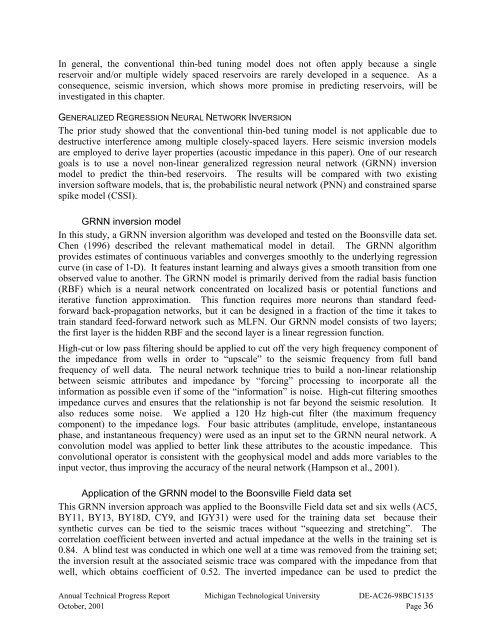Calibration of Seismic Attributes for Reservoir Characterization ...
Calibration of Seismic Attributes for Reservoir Characterization ...
Calibration of Seismic Attributes for Reservoir Characterization ...
You also want an ePaper? Increase the reach of your titles
YUMPU automatically turns print PDFs into web optimized ePapers that Google loves.
In general, the conventional thin-bed tuning model does not <strong>of</strong>ten apply because a singlereservoir and/or multiple widely spaced reservoirs are rarely developed in a sequence. As aconsequence, seismic inversion, which shows more promise in predicting reservoirs, will beinvestigated in this chapter.GENERALIZED REGRESSION NEURAL NETWORK INVERSIONThe prior study showed that the conventional thin-bed tuning model is not applicable due todestructive interference among multiple closely-spaced layers. Here seismic inversion modelsare employed to derive layer properties (acoustic impedance in this paper). One <strong>of</strong> our researchgoals is to use a novel non-linear generalized regression neural network (GRNN) inversionmodel to predict the thin-bed reservoirs. The results will be compared with two existinginversion s<strong>of</strong>tware models, that is, the probabilistic neural network (PNN) and constrained sparsespike model (CSSI).GRNN inversion modelIn this study, a GRNN inversion algorithm was developed and tested on the Boonsville data set.Chen (1996) described the relevant mathematical model in detail. The GRNN algorithmprovides estimates <strong>of</strong> continuous variables and converges smoothly to the underlying regressioncurve (in case <strong>of</strong> 1-D). It features instant learning and always gives a smooth transition from oneobserved value to another. The GRNN model is primarily derived from the radial basis function(RBF) which is a neural network concentrated on localized basis or potential functions anditerative function approximation. This function requires more neurons than standard feed<strong>for</strong>wardback-propagation networks, but it can be designed in a fraction <strong>of</strong> the time it takes totrain standard feed-<strong>for</strong>ward network such as MLFN. Our GRNN model consists <strong>of</strong> two layers;the first layer is the hidden RBF and the second layer is a linear regression function.High-cut or low pass filtering should be applied to cut <strong>of</strong>f the very high frequency component <strong>of</strong>the impedance from wells in order to “upscale” to the seismic frequency from full bandfrequency <strong>of</strong> well data. The neural network technique tries to build a non-linear relationshipbetween seismic attributes and impedance by “<strong>for</strong>cing” processing to incorporate all thein<strong>for</strong>mation as possible even if some <strong>of</strong> the “in<strong>for</strong>mation” is noise. High-cut filtering smoothesimpedance curves and ensures that the relationship is not far beyond the seismic resolution. Italso reduces some noise. We applied a 120 Hz high-cut filter (the maximum frequencycomponent) to the impedance logs. Four basic attributes (amplitude, envelope, instantaneousphase, and instantaneous frequency) were used as an input set to the GRNN neural network. Aconvolution model was applied to better link these attributes to the acoustic impedance. Thisconvolutional operator is consistent with the geophysical model and adds more variables to theinput vector, thus improving the accuracy <strong>of</strong> the neural network (Hampson et al., 2001).Application <strong>of</strong> the GRNN model to the Boonsville Field data setThis GRNN inversion approach was applied to the Boonsville Field data set and six wells (AC5,BY11, BY13, BY18D, CY9, and IGY31) were used <strong>for</strong> the training data set because theirsynthetic curves can be tied to the seismic traces without “squeezing and stretching”. Thecorrelation coefficient between inverted and actual impedance at the wells in the training set is0.84. A blind test was conducted in which one well at a time was removed from the training set;the inversion result at the associated seismic trace was compared with the impedance from thatwell, which obtains coefficient <strong>of</strong> 0.52. The inverted impedance can be used to predict theAnnual Technical Progress Report Michigan Technological University DE-AC26-98BC15135October, 2001 Page 36
















